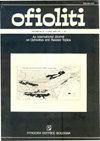THE OPHIOLITE-BEARING MÉLANGE IN THE EARLY TERTIARY PINDOS FLYSCH OF ETOLIA (CENTRAL GREECE)
IF 1.3
4区 地球科学
Q2 GEOLOGY
引用次数: 16
Abstract
In Etolia (Central Greece), west of the Parnassus/Vardoussia units, the Pindos succession crops out, with its higher formation: the Pindos Flysch. In its upper portion levels of debris flow deposits and slide blocks (olistostromes and olistoliths) contain ophiolitic material with fragments derived from the Parnassus/ Vardussia formations. This ophiolitic material consists of serpentinites, basalts of WPB, E- and N-MOR affinity, and radiolarian cherts of Middle-Late Triassic and Middle-Late Jurassic age. Petrologic and biostratigraphic analyses confirm that the melange has the same features of the sub-ophiolitic melanges present at the base of the ophiolitic masses in Greece. Linked to the flysch, with contacts of unclear nature, a rhyolites body of Middle Triassic age indicates the continental nature of the Pindos Basin. In fact, here, as all over the Albanian-Greek section of the Dinarides, no record of an oceanic area in the central portion of the Dinarides exists: the Parnassus and Vardoussia units were directly thrust onto the Pindos Basin. The intercalations of ophiolitic and continent-derived material in the flysch, are interpreted as the forerunners of the Ophiolitie Nappe which, coming from the Vardar Ocean located to the east, reached during the Eocene the Pindos Basin.伊托利亚(希腊中部)早第三纪pindos复理岩中含蛇绿岩mÉlange
在埃托利亚(希腊中部),帕纳萨斯/瓦尔杜西亚单位以西,平多斯演替出现,其较高的地层:平多斯弗莱什。在其上部的碎屑流沉积物和滑块(橄榄岩和橄榄岩)含有蛇绿岩物质和来自Parnassus/ Vardussia地层的碎片。蛇绿质物质由蛇纹岩、WPB、E-和N-MOR亲和玄武岩、中晚三叠世和中晚侏罗世放射虫质燧石组成。岩石学和生物地层学分析证实,该混杂岩与希腊蛇绿岩块底部的亚蛇绿岩混杂岩具有相同的特征。中三叠世流纹岩体与复理石相联系,接触性质不明确,表明品多斯盆地具有大陆性质。事实上,在这里,和在整个第纳里德斯群岛的阿尔巴尼亚-希腊部分一样,在第纳里德斯群岛的中部并没有海洋的记载:帕那萨斯和瓦尔杜西亚群岛是直接被推到平多斯海盆上的。复理石中蛇绿岩和陆源物质的插补被解释为蛇绿岩推覆体的前身,蛇绿岩推覆体来自东面的瓦尔达尔洋,在始新世到达品多斯盆地。
本文章由计算机程序翻译,如有差异,请以英文原文为准。
求助全文
约1分钟内获得全文
求助全文
来源期刊

Ofioliti
地学-地质学
CiteScore
2.40
自引率
7.70%
发文量
1
期刊介绍:
Since 1976, Ofioliti provides an international forum for original contributions and reviews in the field of the geodynamics, petrology, geochemistry, biostratigraphy, stratigraphy, tectonics and paleogeography applied to ophiolitic terrains and modern oceanic lithosphere, including their sedimentary cover. Studies of topics such as geodynamics of the mantle, the evolution of orogens including ophiolites and paleoceanography are also welcome
 求助内容:
求助内容: 应助结果提醒方式:
应助结果提醒方式:


